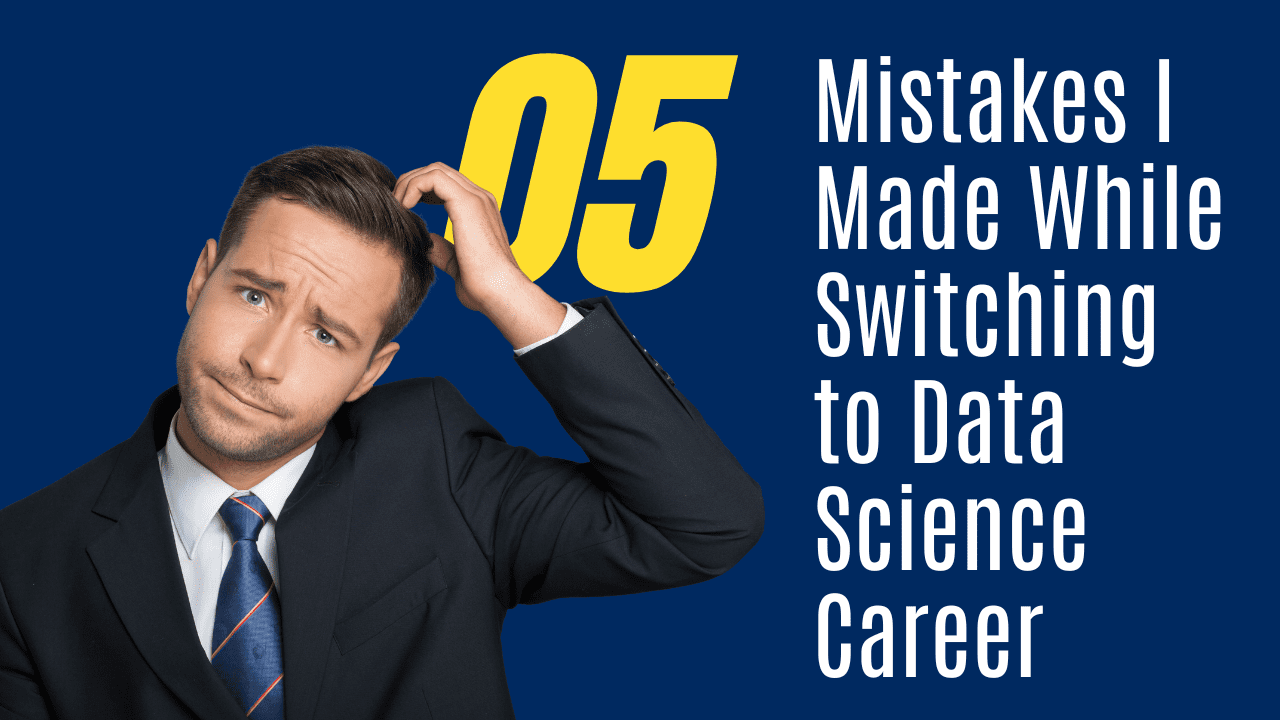5 Mistakes I Made While Switching to Data Science Career
Learn from my mistakes and avoid making the same mistakes.

Image by Author
I transitioned from technology management to data science because I was interested in the analytical aspect of my previous career. Incorporating IoT (Internet of Things) into business and utilizing various analytical techniques to collect and analyze data was highly valued in the past. I have started learning programming, statistics, and multiple data terminologies to pursue data science.
In this blog, I will share five mistakes that have cost me both time and energy. Additionally, I will provide proposed solutions to avoid making these mistakes in the future.
1. Taking Random Courses
I was trying to learn data science by watching random free courses on YouTube or Coursera, but it only left me feeling more confused. Even though I thought I understood what I was learning, I couldn't solve problems on my own.
After three months of this, I realized I needed a more structured approach. That's why I decided to take the career track from DataCamp. This program includes all the necessary courses to understand the basics of data science. The career track also has guided projects, interactive exercises, and assessment tests that have helped me build more confidence in my analytical abilities.
Solution: Consider enrolling in a paid career track that offers various interactive courses covering both basic and advanced concepts. Many reputable educational platforms provide this option.
2. I Didn't Take Math and Statistics Seriously Enough
You must understand the mathematical basis behind models to maintain your professional reputation. I have experienced embarrassment in job interviews, meetings, and while creating documentation due to this. I vividly recall an interview where an expert asked me about the gradient descent equation, and I was unable to provide an answer. It was then that I realized I needed to revisit and strengthen my understanding of statistical fundamentals.
Solution: It's advisable to take a statistics and probability course and understand how machine learning models work mathematically.
3. Not Documenting my Work
Although I have worked on several projects and Kaggle competitions, I failed to document my progress and achievements. It took me a year to realize the importance of documenting both my project and journey, which can help me secure better job opportunities and build a stronger portfolio. In hindsight, I should have shared my journey on LinkedIn and Medium from the outset. Doing so would have allowed me to make new connections, expand my reach, enhance my professional portfolio, and facilitate collaboration.
Solution: To showcase your project, it's best to share the project elements and code on GitHub. You can also write a blog post about it on Medium and share it with the LinkedIn data science group. This will help you get more exposure.
4. I Applied for the Wrong Jobs
In the past, I applied for all data scientist, data analytics, or business intelligence jobs without researching what companies were seeking. I believed I could effortlessly transition into data science. However, I underestimated the extensive knowledge and skills required for the field. To succeed, it's crucial to remain humble, acknowledge your knowledge gaps, and commit to continuous learning.
To succeed in the industry, it's important to familiarize yourself with the standard practices and acquire relevant skills. If you lack experience, consider seeking internships or contributing to reputable open-source projects.
Solution: Once you've finished the essential course, focus on building a robust data science portfolio. Take the time to research job expectations and requirements, and continuously learn new tools and skills to enhance your resume. Avoid applying for jobs immediately and instead, strive to fully understand what potential employers are looking for in a candidate.
5. Participating in too many Competitions
After discovering some tricks about machine learning, I began participating in competitions on Kaggle. I became addicted, even joining contests without prior knowledge of the topic. I convinced myself that I was learning new techniques from others, but in reality, I was just wasting my time.
As an advocate for learning machine learning through competitions, I must warn newbies that winning is difficult. While I came close and often placed among the top 1%, it did not add any significant value to my career. Instead, I should have focused on real-world projects or sought experience through internships or jobs.
Solution: Don't fool yourself. Always keep your goals in mind. Instead of spreading yourself too thin by participating in too many competitions, consider focusing on a complex open-source project, writing on Medium, building your portfolio, and getting involved in community events.
Final Thoughts
I have made many mistakes, and they have taught me a lot about myself and where I stand. The only thing that kept me going through hard times was the dedication and clear goals. It might take me longer than others, but I wasn't going to quit.
If you feel discouraged and believe that the task at hand is too difficult, I suggest that you explore other options that work for you. Don't let anyone discourage you. Keep trying, and you will eventually find a system that suits you and helps you achieve your dream job. Additionally, it's crucial to work on building your data science portfolio from the beginning by utilizing platforms such as Kaggle, GitHub, DagsHub, and Deepnote.
Abid Ali Awan (@1abidaliawan) is a certified data scientist professional who loves building machine learning models. Currently, he is focusing on content creation and writing technical blogs on machine learning and data science technologies. Abid holds a Master's degree in Technology Management and a bachelor's degree in Telecommunication Engineering. His vision is to build an AI product using a graph neural network for students struggling with mental illness.
